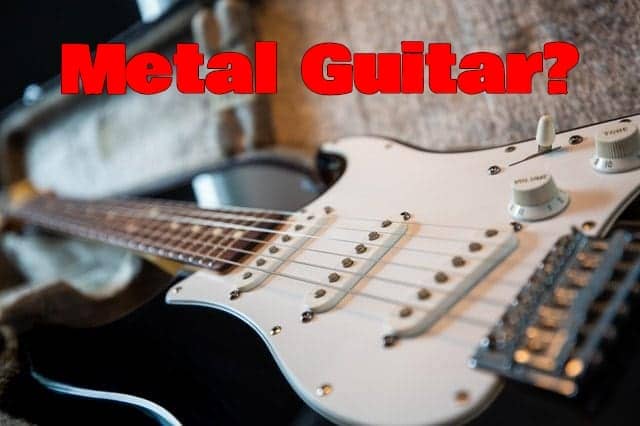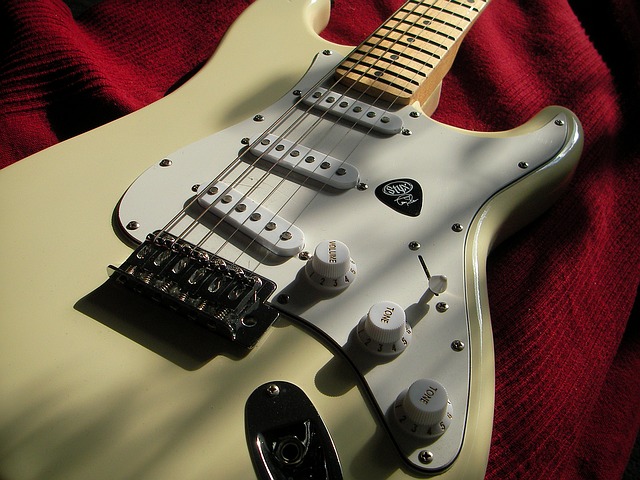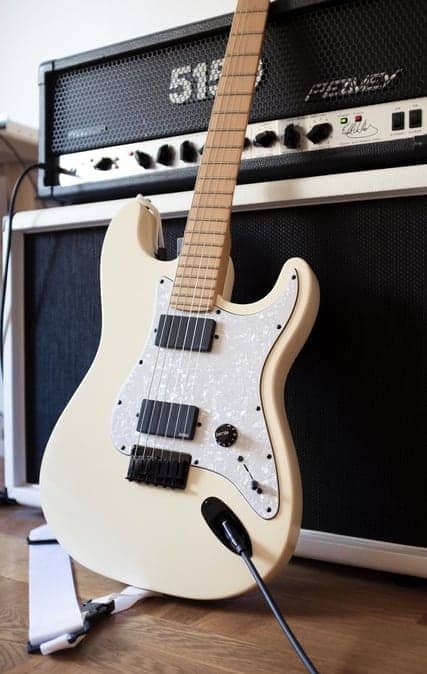
A phrase you may have heard about the legendary Stratocaster is… ‘it is the most versatile guitar you can own.’
And not many people can disagree with this statement! Mainly because the Strat is utilized by guitarists in a wide range of musical genres, usually the heavyweight when it comes to blues, rock, and country.
But can its versatility stretch to the heavy-sounding genre (and many sub-genres) of metal? So let’s dive right in!
Can a Stratocaster play metal? The usual verdict goes like this….
A stock Stratocaster installed with single-coil pickups is not favored for playing any genre or sub-genre of metal. This is due to the ‘60 cycle hum’ and ‘feedback’ that is prevalent when you combine a single-coil guitar with a highly distorted and saturated tone, which is the identifiable guitar tone of metal.
Why Single Coil Strats are Not Metal?

As I just mentioned above, this is only true with Stratocasters armed with single-coil pickups.
Some of the issues that arise tonally when you slap a bucket load of gain and distortion on a guitar with single coils are…
- 60 Cycle hum
- Feedback
- Thin and brittle tone
- Exsessive treble
- Over emphasized high-end frequencies.
- No bass or bottom-end
To know why single-coils are traditionally not used for metal. You can read my post on the top reasons why to avoid single-coils for high-gain tones.
Hum or Buzz
‘60 cycle hum’ is the irritating ‘humming’ or ‘buzzing’ when your guitar is idle ruining the sound for studio sessions and creating an annoying sound for your audience when playing live.
Guitar hum also becomes more apparent when the distortion and master volume is increased.
A feature of single coils is although they are thinner and sound great when combined with overdrive and mild amounts of distortion.
However, they cannot cancel the ’60 cycle hum’ when combined with heavy distortion and saturation which is not ideal for high gain and distortion associated with metal tones.
Keep in mind, humming issues can be solved by adding a noise gate but this can remove some small sonic qualities from the tone.
It must be noted, hum issues can be caused by electronic issues and unshielded electronics within the guitar.
Feedback
Feedback can occur with humbuckers but single coils are known for being the worst candidates for feedback with a tone loaded with heavy amounts of distortion.
You can stand further away from the amp or again, use a noise gate pedal to solve feedback issues.
Tone Not Suitable for Metal
The tone of a regular Stratocaster with single coils is iconic for being ‘bright’ ‘thin’ and ‘twangy’. This is perfect for creating ‘pristine clean tones’ and ‘crunchy rock tones’ when you add a mild amount of dirt and distortion.
The guitar’s design and versatility also combine well for overdriven tones for blues lead solos.
For these reasons, the Strat was made popular and immortalized as the main guitar for many legendary guitarists in the country, blues, and rock genres.
For the dropped tuned and high gain ‘chugging’ however, a ‘thin-sounding guitar is not ideal for the ‘bottom end’ and usually required a ‘tight’ and ‘fat’ sound of metal rhythm playing.
This tone will sound ‘brittle’, ‘
Regardless of pickup choice, the Stratocaster is geared towards being a ‘thin’ and ‘bright’ sounding guitar due to its thin body design, double cutaway, 25.75″ scale length, and maple neck.
Adding a single coil to the equation combined with its design is what gives its iconic trebly and articulate tone. This is great for many genres of music but not geared towards the heavier sounds of metal.
This Video Explains Perfectly
How to Make a Strat Metal
The truth is the Stratocaster can be the ideal metal guitar when it includes a set of ‘humbuckers‘, either being ‘active’ or ‘passive.’ The image below is a modified Strat with a pair of EMG active pickups (looking very sweet).

The reason why the Strat can be an awesome metal guitar is for the following reasons…
- Highly playable guitar (comfortable neck)
- Comfortable to play (light and includes body contours)
- Highly Customizable (swap necks, modify electronics, swap pickups, change bridge)
- Longer scale length (Larger frets better for big hands)
- Brighter tone (cuts through a band mix on stage)
- More identifiable sound next to another guitarist
- Great access (great for high register lead solos)
- Stands out next to the norm metal guitars
Famous Metal Strat Guitarists
Some famous guitarists were not afraid to load some heavy distortion on a Stratocaster.
- Adrian Smith (Iron Maiden)
- Dave Murray (Iron Maiden)
- Glenn Tipton (Judas Priest)
- KK Downing (Judas Priest)
- Eddie Van Halen
- Yngwie Malmsteen
- Jim Root (Slipknot)
Why Use Humbuckers on a Strat?
The truth is any guitar can be suitable for playing any form of metal when equipped with ‘humbuckers’ in the bridge position.
Humbuckers are designed with an additional coil with its coil direction and magnet direction being reversed creating a noise removing effect eliminating hum from the signal making it better suited for saturated high gain.
This is especially true of the Strat. The reason that these pickups are optimal for metal tones is for…
- Canceling hum and buzzing
- Lowering feedback
- Adding bass and thickness to the tone
- Darker sound
- Higher output
- Removing twang and high end treble
- Handling high distortion and saturated tones
Hence why you will rarely or never see the classic Stratocaster we all typically think of being used for any modern style of metal.
Humbuckers either ‘active’ or ‘passive’ are preferred for a thicker tone, handling high distortion, ‘canceling hum’, and a more suitable metal tone when paired with high distortion and saturated tones.
Humbuckers will also offer a ‘darker sound’ compared to the usual ‘rich’ and ‘bright’ tone of the unmodified Stratocaster single coils.
Active or Passive Humbuckers?
Pickup choice ultimately depends on tastes, the genres you play, and the tones you want to achieve. Let’s look at these pickups more closely. Which ones would you choose?
Active Humbuckers
Active pickups are arguably the most popular pickup choice for metal guitars the most common being EMG pickups.
The classic combination is the 81 in the bride and the 85 in the neck. the reason is that ‘active’ pickups are high output resulting in tons of gain for saturated distortion.
They also provide the best string definition when combined with high gain saturated notes preventing a ‘muddy’ and ‘loose’ tone and they are the quietest pickup when it comes to hum and feedback being virtually silent.
For these reasons alone, they are very popular with metal and rock guitarists.
The negative with active pickups, however, is they require a 9V battery and a powered preamp to function and are not the best option for bright clean tones as they remove ‘dynamics’ and ‘clarity’. Another criticism is that they sound ‘sterile’.
My advice is If you are only concerned with high gain distortion and less bothered about crystal clear tones then active pickups are the way to go.
Passive Humbuckers
Passive humbuckers have the benefit of offering more versatility as they provide a lot of dynamic range. The frequency range means they perform great all the way
They do not have as much clarity and definition as active pickups when it comes to the high gain distortion but make up for it in versatility. They also have the added benefit of not requiring a 9V battery.
Passive pickups are the perfect all-round choice for playing the lighter genres such as country, jazz, blues all the way to the heavier genres such as rock and metal.
Hot Rails
Hot Rail pickups are essentially humbuckers squashed into the size of a single-coil pickup. Hot Rails can come in ‘active’ and ‘passive’ forms to easily slot into a single-coil body cavity.
Which Pickups are Best?
So if you are thinking of buying a Strat or modifying your current Strat with the intention of playing metal or other genres. The pickup you choose entirely depends on the genres you intend to play and which
Active
The usual choice if you want an “all-out metal guitar” meaning you are only concerned with a guitar fully optimized for high gain and saturated tones for ‘shredding’, ‘djent’, ‘chugging’, ‘breakdowns’, ‘drop-tuned riffage’ etc.
Basically playing all styles of metal because that’s all you intend to play and not bothered about losing clarity, definition, and character when it comes to the clean and crunch tones.
Passive
They are a more versatile choice for playing a wide range of tones including clean, crunch, and all the way to heavy distortion meaning they are more suited for a wider range of playing styles and musical genres.
They may be not as optimized for the heavy saturation of active pickups but they make up for it in versatility.
The choice you go with is the pickups that you think sound better tonally and the genres that you are most likely to play.
If you want more information about the differences between passive and active pickups for metal. You should read my blog post all about this topic here!
Modifying your Stratocaster
Luckily the Stratocaster is one of the most customizable guitars on the planet.
The body construction is designed to fit a humbucker pickup in the bridge and neck position (even if comes stock with single coils) without needing to cut any additional space in the body. Meaning that it won’t need any heavy modifications and keep the cost to a minimum.
If you have soldering experience and understand pickup electronics you re-wire them yourself otherwise, take it to your local guitar shop for an experienced tech to install them.
Thanks for Reading!
Now we’ve done the Stratocaster – what about the Telecaster? I wrote an extensive post on the reasons why a Telecaster can make for such an awesome metal guitar. You read this post here!
